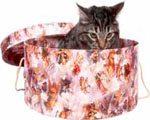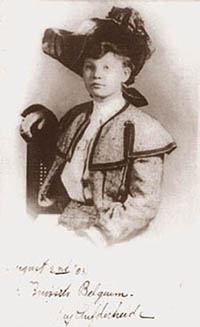The venerable American comic strip doesn't seem as popular, or as influential, as it had been when people hung on every word of Dick Tracy, L'il Abner, and Pogo. This led some to make gloomy pronouncements about the end of that art form. Is the real problem, though, not that the medium itself is dated, but that its policies regarding appropriate content are stuck in 1953?
I'm inclined toward the latter view.
It used to be that comics were a bit ahead of the curve when it came to social trends. When Morrie Turner's "Wee Pals" came along in 1965 (the first mainstream strip with a multiethnic cast) the floodgates opened for the inclusion of non-stereotypical minority characters in comics. But some syndicate editor, somewhere, had the courage to be first, and had the foresight to realize the cataclysmic societal changes taking place around him.
No one's doing that today. Lynn Johnston's "For Better Or For Worse" managed to break new ground by outing the best friend of one of the characters as gay back in the nineties. Since then, however, newspaper comics have been in a holding pattern, retreating to the same old situations and formulaic jokes. They're too fearful of offending aged Aunt Minnie in Duluth, on the assumption that only folks like her are reading comic strips these days. It isn't true--just let an editor drop a beloved strip and watch the flood of irate responses pour in. They can't all be coming from nice old grannies. Yet they hold to that attitude, to the degree that it could become a self-fulfilling prophecy.
Part of the problem, too, is that newspaper strips have increasing competition from something they could easily have laughed off as recently as a decade ago. The internet.
Just as broadcast TV had to compete with the relative freedom of cable, newspaper syndicates are going to have to compete with the no-holds-barred webcomic if they want to avoid becoming as much a relic of the past as running boards and whalebone corsets. (An ironic attitude for your ragtime gal to take, I know, as she likes running boards, if not corsets. But nostalgia has its place, and its limits).
After reading Christine Smith's wonderful web strip "The Princess" recently, I began to think, "Here we have an emerging minority, one that's increasing in influence as well as in number. Chances are good that every cisgendered person is going to meet, grow up with, live next door to, or work alongside one of us sooner or later." Therefore, doesn't it make sense for mainstream comic strips to acknowledge that fact?
"The Princess" is, to me, the perfect candidate to go mainstream, being well-drawn and well-plotted, with memorable characters, which is more than can be said of much of what is in newspapers these days. Even though many of the characters are gender-nonconforming, including most of the kids, it's done in a very inoffensive way, without pulling punches.
It's something I would love to try myself, in fact. I've held off up to now for one reason, and it's not fear of offending non-TG readers. I fear I would offend other transpeople. I was once on a mailing list with transpeople who had transitioned at a young age. They are generally distrustful of those who, like me, transitioned in their thirties or later, and accused us of trying to co-opt their experience. Any strip I do would have a child as protagonist, as does The Princess, simply because I feel I can write kids more easily. I was not like Sarah--I didn't cross-dress or openly express any gender difference as a small child, so can I safely write about those who did? I'm guessing Christine Smith transitioned as an adult, but she seems to understand transkids pretty well. But I don't know yet whether I'd do them justice. If not me, however, someone will.
And if syndicate editors are smart, they'll sign that someone to a long contract.


Comments
Won't happen
Having worked for a major metropolitan newspaper for 18 years I can tell you right now that a TG strip would not run much less be syndicated. Comics are one of the most popular sections of the paper and as such have the ability to entertain or anger a great number of subscribers. As the printed newspapers' readership is generally older than the overall population it is not financially feasible to alienate any more readers than are already alienated simply by the news itself. Most papers are already experiencing a steady loss of readership and they are looking for ways to stem the tide not add to it.
Commentator
Visit my Caption Blog: Dawn's Girly Site
Visit my Amazon Page: D R Jehs
I think that Doonesbury ...
... could cope easily with a trans character. There's already a gay one (Mark, the talk radio host) and while the stereotypical conservative jock (in US terms) ,BD, seems to be getting softer after his military service in Iraq (I think, rather than Afghanistan) he could certainly be persuaded to provide the anti-trans foil story-lines might need.
It's the only comic strip I follow because it's published in the Guardian every day and I'm a subscriber. It's mostly a political strip and is probably seen in the US as rabidly left wing but it's fairly middle-of-the-road liberal (in our wishy-washy sense) over here.
But I guess you're talking about drawing one yourself rather than seeing a trans character in an existing strip. I wonder if it would be possible to carry a consistently trans story-line over a prolonged time and hope to hold the interests of a broad-based readership. Doonesbury's story-lines roam far and wide and could easily touch on any topic for a while, including a trans-based one.
Robi
It's okay
to have psychos like Calvin in comic strips because he's below the age of sexual awareness, so he can get away with anything. Once you bring anything other than normal gender roles, it's unlikely to be published, except on the web. As this is increasing in influence and newspapers are declining, it might be the most suitable place to publish it.
Angharad
Mainstream
I'd guess the most likely first mass-market TG comic strip would be something like "Tyler Perry's Madea: the Comic."
Has the time come for a "mainstream" TG comic strip?
Marvel and DC comics have T.G. heroes and villains. Time that they have a mainstrean T.G, comic.
May Your Light Forever Shine
Has the time come for a "mainstream" TG comic strip?
I think the time had come in the fifties when I had a lot of support from the girls and the boys where I lived. They accepted me as the girl, now woman, that I am. I have never hid behind fear, but bravely went where no TS person ever went back then, except for maybe Christine Jorgensen. I figured if she had the courage to openly be who she is, and had the courage to go and become physically female, then I, too, should have the courage to openly be me. I grew up with so much support in the fifties, that I still take with me in to my stories.
This little query, though, is very timely, in that attitudes are changing, and so, with that in mind; yes! It is time for a mainstream TG comic strip...maybe even a TG comic book.
"With confidence and forbearance, we will have the strength to move forward."
Love & hugs,
Barbara
"If I have to be this girl in me, Then I have the right to be."
I do know this....
...if I, or anyone else, were to attempt such a thing, it might be best to go the Lynn Johnston route: wait until the strip is established, then let the transgender character be a long-standing member of the supporting cast, not the star. Say, the main character's best friend. It would certainly shake up the character dynamic, that's for sure. Finding out someone is trans is one thing--finding out your best friend is, that's quite another.
As it was, Johnston's strip was popular enough that she was able to weather the storm--she lost a fairly small number of papers as a result of the "outing" story arc.
I do wish I had your courage--I can't imagine trying to live as female in the fifties. I doubt I pass well enough to be that stealth. I grew up in a time (the '60s and '70s) and in locations (the deep south and various military towns) where declaring I was a girl inside would have been met with laughter at the very least. It's kind of a sore issue with me, and one I might talk about in future postings--if I had the opportunity to grow up in more tolerant circumstances, would I have been more openly feminine? I don't know, and it irritates me that I don't know.
Livin' A Ragtime Life,

Rachel
So You think you can Pass?
...a comic; whether in the 'funnies' or as a comic book...I believe would be destined to fail at this time if the main character was TG and the thrust of the storylines were highly emphatic in the direction of transgender. The reason? The demographic for the readers is too small to risk a start up on the comic book and the demographic to the contrary in newsprint comic strips is too big in an industry that is slowly but surely shrinking in readership.
As far as a part of a cast character, I can think of no better comic strip to introduce a Mtf or even an FtM character than Tom Batiuk's Funky Winkerbean. As far as comic books; perhaps introducing a 'superhero' in the context of an ensemble cast as well, like Justice League or The Avengers.
The thing to remember is that as altruistic as it may appear to be; the writers might be very interested in introducing a TG character, but the publisher has to think about what sells and what doesn't. Right now? I don't thing it would be a profitable enough move to make as much as I'd love to see an aging Henry Pym transition into a Henrietta, a chic mature teacher at the Avengers Academy...or Hi coming out to Lois? I don't think it will happen any time soon.
Love, Andrea Lena
Mantra
There was a TG comic book, originally from Malibu, called Mantra. Marvel bought Malibu and continued the comic but with some changes. Then they pretty much cancelled the whole Malibu line though Mantra was as successful as any of the others, really.
Mantra was a young mother who was inhabited and her soul suppressed by the soul of an ancient male warrior. Using her dual nature gave her access to some mystic energies besides the fact that her male self had centuries of fighting skill that mostly carried over into the female body. It was an interesting comic.
Hugs,
Erin
= Give everyone the benefit of the doubt because certainty is a fragile thing that can be shattered by one overlooked fact.
another
Over on the DC side of the comics world, didn't Milestone have a comic with a TG character?